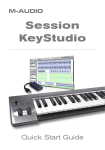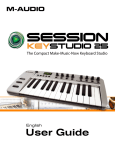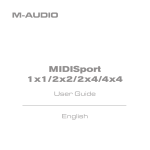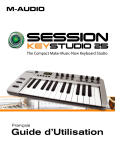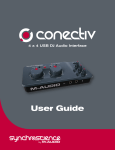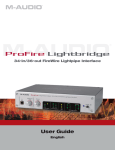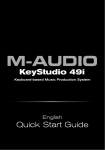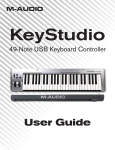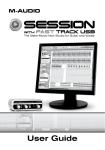Download M-Audio SESSION User guide
Transcript
Session KeyStudio Quick Start Guide Session KeyStudio Quick Start Guide Introduction . . . . . . . . . . . . . . . . . . . . . . . . . . . . . . . . . . . . . . . 1 Session KeyStudio Features. . . . . . . . . . . . . . . . . . . . . . . . . . . 1 KeyStudio Keyboard:. . . . . . . . . . . . . . . . . . . . . . . . . . . . . . . . . . 1 Micro USB Audio Interface (PC only) . . . . . . . . . . . . . . . . . . . . . . . . . . . 1 Session Software (PC only). . . . . . . . . . . . . . . . . . . . . . . . . . . . . . . What’s in the Box? . About This Guide . 1 . . . . . . . . . . . . . . . . . . . . . . . . . . . . . . . . . 2 . . . . . . . . . . . . . . . . . . . . . . . . . . . . . . . . . . 2 Minimum System Requirements. . . . . . . . . . . . . . . . . . . . . . . . 3 Windows XP (SP2) . . . . . . . . . . . . . . . . . . . . . . . . . . . . . . . . . . . 3 Windows Vista 32-bit. . . . . . . . . . . . . . . . . . . . . . . . . . . . . . . . . . 3 Mac OS X (KeyStudio keyboard only). . . . . . . . . . . . . . . . . . . . . . . . . . . 3 Installation and Setup Overview for Windows XP and Windows Vista . . . . . . . . . . . . . . . . . . . . . . . . . . . . . . . . 4 Connecting the KeyStudio Keyboard to your PC . . . . . . . . . . . . . 4 Installing the M-Audio Session Software (Windows only) . Setting Up the Micro USB Audio Interface. . . . . . . . . . . . . . . . . . 7 Getting Started making Music with Session. More Information on Configuring Session . . . . . . . . 5 . . . . . . . . . . . . . . . . 8 . . . . . . . . . . . . . . . . 11 ASIO/WDM Driver Type Switch. . . . . . . . . . . . . . . . . . . . . . . . . . . . . 11 Input Channels and Output Channels. . . . . . . . . . . . . . . . . . . . . . . . . . 12 The Latency Slider . . . . . . . . . . . . . . . . . . . . . . . . . . . . . . . . . . . 12 More Information About Latency. . . . . . . . . . . . . . . . . . . . . . . . . . . . . 12 OK Button. . . . . . . . . . . . . . . . . . . . . . . . . . . . . . . . . . . . . . . 12 Cancel Button . . . . . . . . . . . . . . . . . . . . . . . . . . . . . . . . . . . . . 12 Mac OS X: Connecting the KeyStudio Keyboard . . . . . . . . . . . . . 13 Using KeyStudio with GarageBand . . . . . . . . . . . . . . . . . . . . . . 13 Additional Information and Support . . . . . . . . . . . . . . . . . . . . . . 16 Warranty . . . . . . . . . . . . . . . . . . . . . . . . . . . . . . . . . . . . . . . . 16 Session KeyStudio Quick Start Guide | 1 Introduction Congratulations on your purchase of M-Audio Session KeyStudio. Session KeyStudio is a complete music production kit containing a 49 full-size key USB keyboard, an audio interface, and music production software designed for easy integration with your Windows XP or Windows Vista computer. The hardware contained in this package is also ideal for use with a multitude of third-party music creation applications. We recommend you spend a few minutes reviewing this Quick Start Guide to ensure proper setup. NOTE: Session KeyStudio is a software and hardware combination designed for Windows. However, the KeyStudio USB keyboard contained in this bundle is also compatible with Apple computers, and is a great companion to GarageBand. On both Windows and Macintosh computers, the keyboard will be ready for use immediately after connecting. Session KeyStudio Features KeyStudio Keyboard: < 49-key velocity-sensitive keyboard < Pitch Bend wheel < Modulation wheel; MIDI re-assignable < Volume slider; MIDI re-assignable < O ctave up/down buttons; MIDI re-assignable < E dit Mode button for advanced functions and programming < Sustain foot pedal input < n o driver installation needed – simply connect and power on < bus-powered through USB Micro USB Audio Interface (PC only):* < seamless Session compatibility < low latency performance through ASIO driver architecture < 1 /8” stereo output for headphones or powered monitors < bus-powered through USB < 1 /8” stereo input for instruments, microphones, and line-level devices *M-Audio Micro circumvents potential high-latency monitoring issues on Windows PCs. The built-in audio hardware on Apple computers enables low latency monitoring without the need for additional hardware. If you are using a Mac, you should simply use your computer’s built-in audio inputs and outputs. | 2 Session KeyStudio Quick Start Guide Session Software (PC only): < C D-quality multi-track audio and MIDI recording software < b uilt-in virtual synthesizer with hundreds of instrument sounds < built-in studio quality effects < includes over 3.5 GB of content for professional music creation What’s in the Box? Your M-Audio Session KeyStudio bundle should contain the following items: < M-Audio KeyStudio USB keyboard < M-Audio Micro USB audio interface < M-Audio Session DVD-ROM < USB cable < This Quick Start Guide If any of the above listed items are missing, please contact the retailer where you purchased the product. About This Guide This Quick Start Guide covers setup of the KeyStudio USB keyboard for Mac and PC computers, as well as installation of the Session music-creation software and the M-Audio Micro USB audio interface for Windows XP and Vista. The KeyStudio keyboard and the Micro audio interface contained in this bundle can also be used with third-party music software. Consult your third party software’s documentation for more information on this. As you become more familiar with KeyStudio, you may wish to take advantage of this product’s professional features such as: using your new keyboard with more than one application at the same time (multi-client) or sending advanced MIDI messages using KeyStudio’s Edit Mode. On PC computers, these features can only be accessed after downloading and installing optional KeyStudio drivers. The KeyStudio drivers can be downloaded free from www.m-audio.com. Session KeyStudio Quick Start Guide | 3 Minimum System Requirements Windows XP (SP2)** < Pentium 4 1.6 GHz processor (CPU requirements may be higher for laptops) < 512MB RAM < 4GB free hard disk space for complete Session software installation < 32MB video RAM✝ < 1024 x 768 video resolution (1280 x 1024 recommended) < DVD drive for Session software installation < Two native USB ports Windows Vista 32-bit < Pentium 4 1.6 GHz processor (CPU requirements may be higher for laptops) < 1GB RAM < 4GB free hard disk space for complete Session software installation < 128 MB video RAM✝ < 1024 x 768 video resolution (1280 x 1024 recommended) < DVD drive for Session software installation < Two native USB ports Mac OS X (KeyStudio keyboard only) < Macintosh G4 1GHz✝✝ < OS X 10.3.9 with 512 MB RAM < OS X 10.4.9 with 512 MB RAM < One native USB port **Home and Professional Edition only. Windows Media Center Edition is not currently supported. ✝Session does not support video cards based on any of the following chipsets: S3/VIA UniChrome, SiS EL315, Matrox. If the video card being used shares system RAM, then overall system RAM requirements may increase by the amount of system RAM shared with the video card. ✝✝G3/G4 accelerator cards are not supported. lease also check the minimum system requirements for third party software P applications that are to be used with your new M-Audio hardware, as they may be greater than the above. 4 | Session KeyStudio Quick Start Guide Windows XP and Windows Vista Installation and Setup Overview for Windows XP and Windows Vista It is important that installation and setup take place in the following sequence (all of these steps are explained in detail later in this Quick Start Guide): 1.Connect the KeyStudio USB MIDI keyboard to your computer and turn it on. 2.Install the Session music creation software. This software enables support for the M-Audio Micro USB audio interface, and must be installed before Micro is connected. 3.Connect the M-Audio Micro USB audio interface. This device serves as a high performance, low latency USB audio interface. Important: The Micro audio interface and KeyStudio keyboard serve as the copy protection key for Session. At least one of these devices must be connected to your computer for Session to launch. Connecting the KeyStudio Keyboard to your PC 1.Use the provided USB cable to connect KeyStudio to an available USB port on your computer. The USB cable not only powers the keyboard but also transmits MIDI data to your computer. 2.Make sure that the power switch on the back of the keyboard is in the “on” ( I ) position. The KeyStudio keyboard is now ready to be used – no additional installation steps are required. Session KeyStudio Quick Start Guide | 5 Installing the M-Audio Session Software (Windows only) the Session software has been installed. Leave your Micro disconnected until instructed to connect it. 1.Insert the M-Audio Session DVD-ROM into your computer’s DVD-ROM drive. 1 2.The computer will automatically display the install screen 1 . If your computer does not launch the installer, manually start it by clicking on Start > My Computer ‡ and then doubleclicking Session. 3.Follow the software installer’s on-screen direction prompts. 4. Session comes with a large library of loops and instrument samples for music creation, known as Session Content. This content requires approximately 4 GB of disk space and may take as long as 30 minutes to install. This behavior is normal. During the installation process, you will be asked if you would like to install this content, as well as the Session Application, and the driver for the Micro audio interface 2 . The M-Audio Micro driver is required in order to use the Micro audio interface. 2 If you do not have 4 GB of disk space available, you may choose not to install the Session Content, but you will then have to place the Session DVD in your DVD-ROM drive whenever you run Session. Accessing Session’s content via DVD-ROM results in slightly slower computer performance. If the required hard drive space is available, installing the Session Content on your computer’s hard drive is recommended. Windows XP and Windows Vista Please Note: Do not connect your Micro audio interface to your computer until 6 | Session KeyStudio Quick Start Guide Windows XP and Windows Vista 5. In Windows Vista, you may encounter the following message while the Micro device driver is installed on your system: “An unidentified program wants access to your computer.” 3 Click Allow to continue installation. 3 6.At various points in this installation process, you may be notified that the driver being installed has not passed Windows Logo Testing 4 , or asked whether the program you wish to run is a trusted application 5 . Click Continue Anyway (Windows XP) or Install (Windows Vista) to proceed with the installation. 4 5 7. Click “Finish” once the installer has completed the installation. ‡My Computer” is simply called “Computer” in Windows Vista. | Session KeyStudio Quick Start Guide 7 Setting Up the Micro USB Audio Interface 6 Windows XP Windows Vista 2.Double-click the red M-Audio icon in the system tray 7 to access the Micro control panel. Here you can adjust input gain, monitor mix levels, output volume, and buffer size (latency). The control panel also shows details about the installed driver version. M-Audio icon Windows XP M-Audio icon 7 Windows Vista 3.In order to hear sound from the Micro, it is necessary to connect headphones or speakers to its 1/8” audio output jack. A microphone can also be connected to the 1/8” microphone input. Important: : Micro serves as a high performance, low latency USB audio interface. This Quick Start Guide describes how to set up Session KeyStudio using the Micro audio interface and ASIO audio drivers. For best low latency performance, we strongly encourage you to use the enclosed Micro. You may be able to use your existing audio interface with Session KeyStudio, and you can find additional information on using Session KeyStudio with alternate audio interfaces in the complete User Guide. This User Guide can be downloaded for free from www.m-audio.com. Windows XP and Windows Vista 1.Once the Micro drivers have been installed via the Session software installation, connect the Micro USB audio interface to an available USB port on your computer. Your computer will recognize the new hardware and will briefly display a Found New Hardware message 6 . In Windows XP, you may be prompted with a Windows Logo testing message. Click Continue Anyway 4 . | 8 Session KeyStudio Quick Start Guide Windows XP and Windows Vista Getting Started making Music with Session 1.Make sure the KeyStudio keyboard and Micro audio interface are connected to your computer, and make sure the keyboard is switched on. 2. Launch Session by clicking the Start button > All Programs > M-Audio > Session > Session. Alternatively, if you chose to create a desktop shortcut icon during installation, you can double-click the Session shortcut icon. 3. Click the button labeled “New” in the Session Startup window. 4.A New Composition dialog box will appear allowing you to choose a Name, Time Signature, Key Root, Key Scale, and Tempo for your composition. After these choices have been made, click OK. Session KeyStudio Quick Start Guide | 9 5. Click the Add a Track button in the upper left corner of the Session Main Screen . 7.In the “Select Keyboard Sound” dialog box, select the bank of sounds you would like to associate with the first track of your new song, and click OK. Windows XP and Windows Vista 6.The “What would you like to do?” dialog box will now appear. For this example, select Play and Record with your Keyboard, and click OK. Windows XP and Windows Vista 10 | Session KeyStudio Quick Start Guide 8. A new track will now appear in the main Session window. You may click the specific instrument you would like to play from the instrument list appearing on the left side of the screen. 9.Try playing notes on your KeyStudio keyboard. If you can hear instrument sounds, you may skip steps 10-12. If your computer does not yet generate sounds via the Micro audio interface when KeyStudio is played, proceed to step 10 for additional configuration instructions. 10. Go to Options > Audio Hardware and confirm that ASIO is selected as the Driver Type. Make sure ASIO: M-Audio USB ASIO is selected in the Audio Device pull-down menu, and M-Audio Micro is selected in the Input Channels and Output Channels pull-down menus. Click OK. See the following chapter, ”More Information on Configuring Session,” for further explanation of this. 11. Go to Options > MIDI Hardware and make sure “USB Audio Device,” “KeyStudio,” or “KeyStudio In” is selected in the Input Port box. KeyStudio will appear as “USB Audio Device” in Windows XP and “KeyStudio” in Windows Vista if additional drivers have not been installed. If the optional drivers are installed, KeyStudio will appear as “KeyStudio In.” Click OK. Figure A: Session MIDI Hardware dialog window without optional drivers installed in Windows XP. Figure B: Session MIDI Hardware dialog window without optional drivers installed in Windows Vista. 12.Provided that speakers or headphones are connected to your selected audio interface, you should now be able to use your KeyStudio keyboard to play instruments from the Session instrument library. Session KeyStudio Quick Start Guide | 11 More Information on Configuring Session Session must communicate with Micro. On first launch, Session attempts to choose the first sound card containing both an audio input and audio output, effectively making this connection automatically. If Session is not able to select audio inputs and outputs automatically, it will open the Audio Hardware dialog. If the process is successful (Session does not open the Audio Hardware dialog automatically), but you cannot play back or record audio with Session, you’ll need to open the Audio Hardware dialog by choosing Options > Audio Hardware. The Audio Hardware dialog contains the following options: ASIO/WDM Driver Type Switch This control switches the Audio Hardware dialog of Session between ASIO and WDM driver mode. Select ASIO, and choose ASIO: M-Audio USB ASIO in the Audio Device pull-down menu Note: The M-Audio Micro utilizes ASIO driver technology. This technology is found in professional audio interfaces and allows for fast access to your audio hardware. Gaming soundcards or built-in audio ports usually do not have ASIO drivers and require more time for audio processing. This causes a distracting delay known as “latency.” This delay occurs between performing an action (e.g. singing or pressing a key on a keyboard) and hearing a sound through your speakers (or headphones). M-Audio’s advanced drivers virtually eliminate this latency and help keep action and sound together. Make sure your microphone and speakers are plugged into Micro, and Micro is plugged into your computer to take advantage of its superior performance. Windows XP and Windows Vista To play back and record audio in Session, 12 | Session KeyStudio Quick Start Guide Windows XP and Windows Vista Input Channels and Output Channels These controls set the Input Channels from which Session records audio and the Output Channels through which Session plays audio. Select M-Audio Micro for Input and Output. The Latency Slider This control is accessed by clicking on the ASIO Settings button in the Audio Hardware window when ASIO is selected as the Driver Type. If Micro is selected as the Audio Device (ASIO: M-Audio USB ASIO), clicking the ASIO Settings button opens the Micro control panel. More Information About Latency With the Micro Control Panel open, click on the Latency tab, and use the slider to adjust the buffer size. Latency is loosely defined as the amount of time it takes for a sound made in Session to reach your speakers. For example, with a high latency (Buffer Size) setting, there will be a noticeable delay between the press of a key on KeyStudio, and the resultant sound. Smaller Buffer Size settings result in lower latency, but may not function well with slower systems. If you hear clicks and pops, the Buffer Size setting is too low. OK Button After making the desired settings, press the OK button to commit your changes and close the Audio Hardware dialog. Cancel Button Press the Cancel button to discard your changes and close the Audio Hardware dialog. Session KeyStudio Quick Start Guide | 13 Mac OS X: Connecting the KeyStudio Keyboard No additional drivers or hardware‡‡ need to be installed to use the KeyStudio USB keyboard on your Macintosh computer. Simply: Close any open applications on your computer. 2.Connect the provided USB cable between the KeyStudio keyboard and your Mac OS X computer. 3. Switch the keyboard on. ‡‡M-Audio Micro circumvents potential high-latency monitoring issues on Windows PCs. The built-in audio hardware on Apple computers enables low latency monitoring without the need for additional hardware. If you are using a Mac, you should simply use your computer’s built-in audio inputs and outputs. Using KeyStudio with GarageBand The M-Audio Session software was created for use with Windows. However, the KeyStudio hardware can be used with Macintosh OS X computers as well. KeyStudio integrates seamlessly with the GarageBand music production software which comes pre-installed on many late-model Apple computers. To use KeyStudio with GarageBand: 1.Be sure KeyStudio is connected to your Mac OS X computer via the provided USB cable. 2. Launch GarageBand. 3.Create a Software Instrument track by clicking Track > New Track > Software Instrument > Create, or select a pre-existing Software Instrument track. The default instrument GarageBand selects is a Grand Piano. When a Software Instrument is selected, clicking the button in the lower right corner of the GarageBand window will open the Track Info screen. From this area, you can select which instrument you would like to play. Provided your computer’s speakers are not muted or turned down, you will now hear sounds corresponding to notes you play on KeyStudio. Mac OS X 1. | Session KeyStudio Quick Start Guide Mac OS X 14 The default instrument GarageBand selects is a Grand Piano. When a Software Instrument is selected, clicking the button in the lower right corner of the GarageBand window will open the Track Info screen. Session KeyStudio Quick Start Guide | 15 Mac OS X From this area, you can select which instrument you would like to play. 16 | Session KeyStudio Quick Start Guide Additional Information and Support More information about your new Session software and the M-Audio Micro audio interface can be found in Session’s built-in help menu. A complete User Guide as well as optional Windows XP and Vista drivers for the KeyStudio keyboard, can be downloaded for free at www.m-audio.com Warranty Warranty Terms M-Audio warrants products to be free from defects in materials and workmanship, under normal use and provided that the product is owned by the original, registered user. Visit www.m-audio.com/warranty for terms and limitations applying to your specific product. Warranty Registration Immediately registering your new M-Audio product entitles you to full warranty coverage and helps M-Audio develop and manufacture the finest quality products available. Register online at www.m-audio.com/register to receive FREE product updates and for the chance to win M-Audio giveaways. ESD and Fast Transient may cause the unit to temporarily malfunction. Switch off and on again to restore normal operation. WARNING: This product contains chemicals, including lead, known to the State of California to cause cancer, and birth defects or other reproductive harm. Wash hands after handling. Session KeyStudio Tested to comply with FCC standards FOR HOME OR STUDIO USE © 2007 Avid Technology, Inc. All rights reserved. Product features, specifications, system requirements and availability are subject to change without notice. Avid, M‑Audio, Session, KeyStudio and Micro are either trademarks or registered trademarks of Avid Technology, Inc. All other trademarks contained herein are the property of their respective owners. M-Audio USA M-Audio Germany 5795 Martin Rd., Irwindale, CA 91706 Kuhallmand 34, D-74613 Ohringen, Germany Technical Support Technical Support web: www.m-audio.com/tech e-mail: [email protected] tel (pro products): (626) 633-9055 tel: +49 (0)7941 - 9870030 tel (consumer products): (626) 633-9066 fax: +49 (0)7941 98 70070 fax (shipping): (626) 633-9032 Sales Sales e-mail: [email protected] e-mail: [email protected] tel: +49 (0)7941 98 7000 tel: 1-866-657-6434 fax: +49 (0)7941 98 70070 fax: (626) 633-9070 Web www.m-audio.de Web www.m-audio.com M-Audio Canada M-Audio U.K. Floor 6, Gresham House, 53 Clarenden Road, Watford WD17 1LA, United Kingdom 1400 St-Jean Baptiste Ave. #150, Quebec City, Quebec G2E 5B7, Canada Technical Support Technical Support e-mail: [email protected] email: [email protected] tel:(Mac support): +44 (0)1765 650072 phone: (418) 872-0444 tel: (PC support): +44 (0)1309 671301 fax: (418) 872-0034 Sales Sales tel: +44 (0)1923 204010 e-mail: [email protected] fax: +44 (0)1923 204039 phone: (866) 872-0444 Web www.maudio.co.uk fax: (418) 872-0034 Web www.m-audio.ca M-Audio France Floor 6, Gresham House, 53 Clarenden Road, Watford WD17 1LA, United Kingdom Renseignements Commerciaux tel : 0 810 001 105 e-mail : [email protected] Assistance Technique PC : 0 0820 000 731 MAC : 0 0820 391 191 fax : Site Web アビッドテクノロジー株式会社 | エムオーディオ事業部 〒 460-0002 愛知県名古屋市中区丸の内 2-18-10 Avid Technology K.K. 2-18-10 Marunouchi, Naka-Ku, Nagoya, Japan 460-0002 カスタマーサポート(Technical Support) e-mail : [email protected] (Macintosh 環境専用): e-mail [email protected] tel : 052-218-0859 (10:00~12:00/13:00~17:00) セールスに関するお問い合わせ(Sales) Assistance Technique e-mail : M-Audio Japan [email protected] [email protected] e-mail: [email protected] tel: 052-218-3375 +33 (0)01 72 72 90 52 fax: 052-218-0875 www.m-audio.fr Web www.m-audio.jp 070716_SssnKyStu_QSG_EN01



















